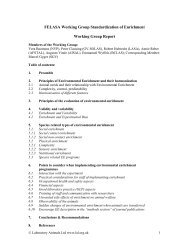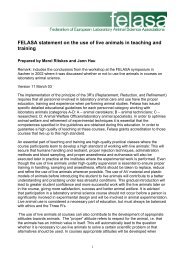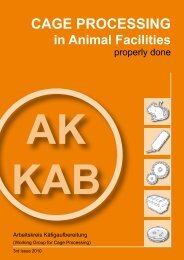CAGE PROCESSING in Animal Facilities - Felasa
CAGE PROCESSING in Animal Facilities - Felasa
CAGE PROCESSING in Animal Facilities - Felasa
- No tags were found...
You also want an ePaper? Increase the reach of your titles
YUMPU automatically turns print PDFs into web optimized ePapers that Google loves.
„Musculoskeletal Load <strong>in</strong> and Highly Repetitive Actions of <strong>Animal</strong> Facility Washroom Employees“ 2011, Journalof the American Association for Laboratory <strong>Animal</strong> Science (AALAS) from the Helmholz-Zentrum forHealth and Environment Neuherberg and the Institute for occupational safety of the German Statutory AccidentInsurance (Deutsche Gesetzliche Unfallversicherung (IFA) - former BGIA)2003 ILAR Magaz<strong>in</strong>e entitled „Eng<strong>in</strong>eer<strong>in</strong>g Controls and Facility Design“- An Ergonomic Process for the Careand Use of Research <strong>Animal</strong>s”.11 Terms / Def<strong>in</strong>itions<strong>Animal</strong> facilityThis term <strong>in</strong>cludes all rooms necessary for operat<strong>in</strong>g an animal facility, also those for dispens<strong>in</strong>g and disposal,like animal rooms, wash-up area / process<strong>in</strong>g centre, halls, storage rooms, eng<strong>in</strong>eer<strong>in</strong>g rooms, locks, and alsolaboratories.<strong>Animal</strong> hous<strong>in</strong>g areaThe rooms <strong>in</strong> which the animals are housed.AOX compoundsAdsorbable organically bound halogens are generated by excess active chlor<strong>in</strong>e when permuted with organicdirt components. The result<strong>in</strong>g halogenated hydrocarbons are not ecologically favourable.Bisphenol ABisphenol A is one of the monomers (reactive molecule) used for generat<strong>in</strong>g polycarbonate.Boil<strong>in</strong>g delayPlease refer to: Danger to life due to boil<strong>in</strong>g delay.CarryoverWith fail<strong>in</strong>gs <strong>in</strong> process management or deficiencies <strong>in</strong> mach<strong>in</strong>e construction, it is possible that residual soil<strong>in</strong>gor detergent solution of a preced<strong>in</strong>g wash<strong>in</strong>g step is carried over to already washed items.CFUColony form<strong>in</strong>g unityChlor<strong>in</strong>e-<strong>in</strong>duced pitt<strong>in</strong>gChlor<strong>in</strong>e-<strong>in</strong>duced corrosion of hollows <strong>in</strong> metal surfaces covered with passive layers.Collection b<strong>in</strong>When cages are emptied, the bedd<strong>in</strong>g is collected or temporarily stored <strong>in</strong> collection b<strong>in</strong>s. These can either bebig plastic bags, bulk conta<strong>in</strong>ers or vacuum conta<strong>in</strong>ers.Correction chemicalsAdditives <strong>in</strong> steam to avoid, for example, corrosion <strong>in</strong>side steam pipes.Danger to life due to boil<strong>in</strong>g delayAfter steam sterilisation, liquids are cooled by means of “back pressure” that is significantly higher than boil<strong>in</strong>gpressure. When the cool<strong>in</strong>g process is f<strong>in</strong>ished, the back pressure is lowered to atmospheric pressure. Insufficientlycooled liquids can then have a temperature higher than boil<strong>in</strong>g temperature without actually boil<strong>in</strong>g. Allit needs for the liquids to suddenly start boil<strong>in</strong>g is a trigger. Such a trigger can be a vibration when the load ismoved out of the chamber. A sudden release of steam can result <strong>in</strong> boil<strong>in</strong>g over or even burst<strong>in</strong>g conta<strong>in</strong>ers.Hot liquids can be spread about. The huge mass of a steam sterilisation load poses a risk of life threaten<strong>in</strong>gscald burns when liquids are <strong>in</strong>sufficiently cooled.Decontam<strong>in</strong>ationDecontam<strong>in</strong>ation describes the process of remov<strong>in</strong>g soil<strong>in</strong>g (wash<strong>in</strong>g process) and reduc<strong>in</strong>g the number ofviable microorganisms to a degree necessary for further process<strong>in</strong>g or use of an object.68Cage Process<strong>in</strong>g <strong>in</strong> <strong>Animal</strong> <strong>Facilities</strong> · 4th issue · 2013






